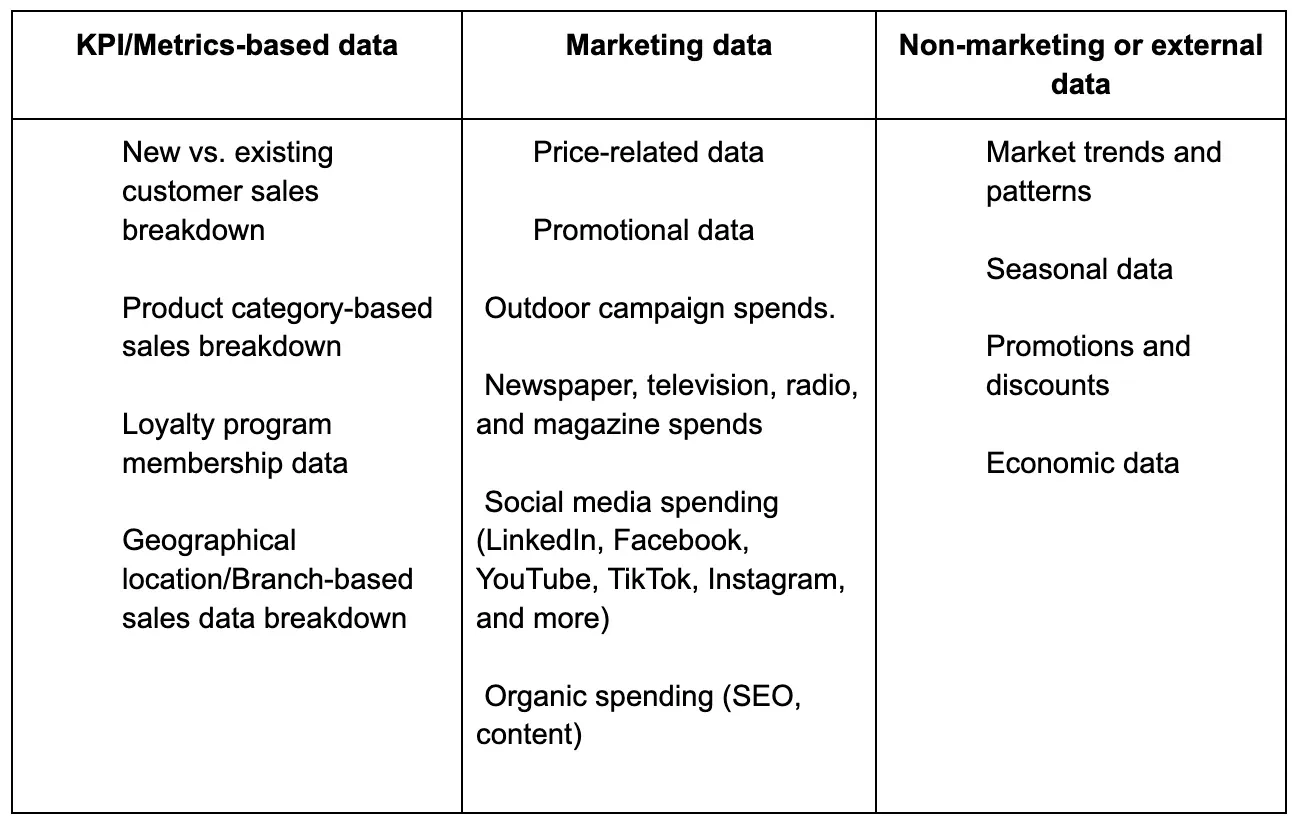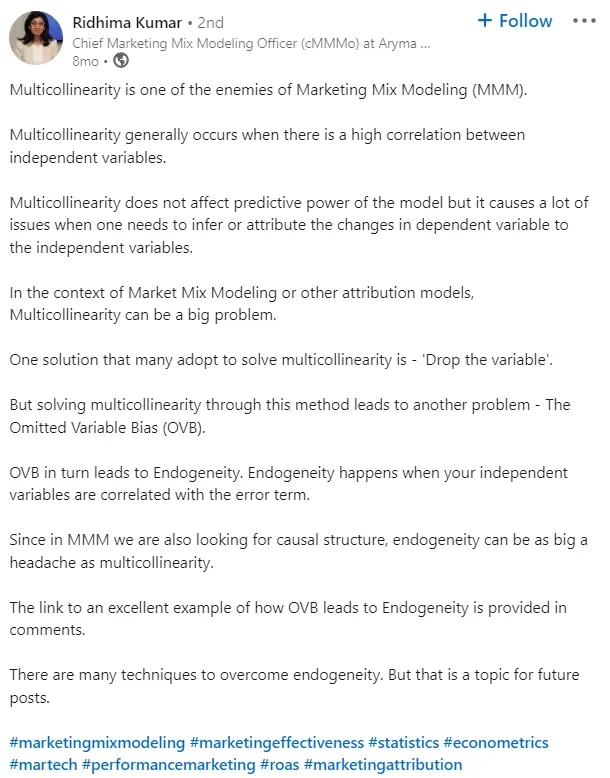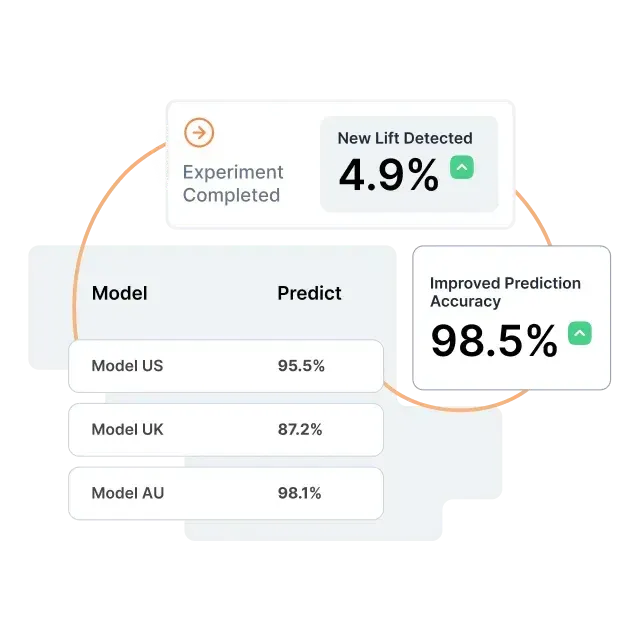According to a study by IBM, poor data can cost businesses $3.1 trillion annually in the U.S alone. When it comes to marketing mix modeling (MMM), which relies heavily on accurate and comprehensive data, these imperfections can make or break a campaign’s success.
Marketing Mix Modeling analyzes cross-channel marketing datasets through statistical methods like multi-linear regression to forecast incremental sales and ROI.
The level of accuracy of an MMM model’s prediction depends on the authenticity, granularity, and accuracy of the data fed to this model. However, challenges like incomplete and multi-collinear datasets affect the final output of the model.
This article will help you identify and address the most common data challenges associated with MMM Models.
The Importance of Quality Data for Marketing Mix Modeling
Data quality plays a critical role in Marketing Mix Modeling. The output accuracy depends on the granularity, quality, and relevance of the input datasets. Irrelevant and inaccurate data increases the processing time of the Marketing Mix Model, and there’s no guarantee that the final output will be authentic.
Suppose you are trying to estimate the effectiveness of LinkedIn as a marketing channel for your brand’s US-based operations on a month-on-month basis. To get complete visibility, you need to feed the Marketing Mix Model with the following inputs:
- Overall sales data for the past few months
- Overall spending on US-based ad campaigns for the past few months
- Any non-marketing or external factors that might have impacted the business
- Organic Marketing Data
- Seasonal sales data
- List of Holidays
- Competitive data (if applicable)
If one or more of the above datasets is missing, the output will be vague, and the predictions will be inaccurate.
The same pattern was observed in this study, where the output’s accuracy level significantly shifted as the level of granularity was changed for the input data. This study was based on 19 MMM studies, and the Marketing Mix Models with regional-level data provided more accurate outcomes than the MMM with state-level data.
Types of Data Used in Marketing Mix Modeling
The data types in MMM can be segmented into three groups: KPI or metrics-based data, marketing data, and non-marketing or external data.
Data Used in Marketing Mix Modeling
Common Data Challenges in Marketing Mix Modeling
Data is the cornerstone of any Marketing Mix Model. However, marketing professionals often face some critical data challenges that impact the business’s overall performance. Below are some of the standard data pitfalls associated with Marketing Mix Models:
Incomplete data
When businesses adopt Marketing Mix Modeling, they often realize they don’t have access to appropriate datasets to measure the effectiveness of cross-channel marketing initiatives.
For example, an ecommerce organization may have been using only country-level data to identify the performance of marketing campaigns for one of its subsidiaries. However, once it applies the Marketing Mix Model, it will realize that the data is incomplete. It needs more distinct data, like regional or city-based breakdowns of sales performance.
While building frameworks to collect such granular data is time-consuming and may take months, MM Models need complete or sufficient data to draw accurate conclusions.
Solutions for incomplete data
Incomplete data-related challenges in MMM can be addressed with techniques like data imputation, forecasting, and deletion.
- Data imputation – The data imputation technique replaces missing data with estimated values. Marketers often use mean, median, and mode to do that. For example, if the sales data for July is missing, you can take the mean value of the sales data for June and August to add an estimated value.
- Forecasting – Time-series forecasting is also used to reverse-forecast the missing data. You can also use the moving average method to recover lost data.
- Deletion – Sometimes, it is best to delete missing data. For example, in a survey or poll, adding missing data based on assumptions is not ethical. In those cases, deleting the respective fields is better.
Lack of measurement standards
Not having a universal measurement standard often becomes a roadblock to implementing Marketing Mix Models. The effects of a marketing campaign can be short-term, long-term, and very long-term.
MM Models often measure the short-term impacts of these campaigns on overall sales. However, due to missing data and limited measurement techniques, estimating factors like repeat purchases that generate long-term impacts on overall sales is challenging.
Most marketing professionals use return on marketing investment (ROMI) and effectiveness techniques to measure the ROI associated with a marketing campaign.
ROMI – Incremental sales on the campaign/ Dollars spent on the campaign.
Effectiveness – Incremental sales from campaign/ Impressions.
Both of these techniques depend on ‘incremental sales from campaigns’. This factor varies a lot for each campaign as the concept of “lead” changes from campaign to campaign. Hence, these techniques only focus on the short-term effects of an initiative on overall sales.
Solutions for lack of measurement standards
A great way to address this challenge is by following the unobserved component modeling technique.
This technique performs a time series decomposition into variables like sales, trends, and seasonality to predict the effectiveness of a campaign. This analysis allows marketers to assess the impact of their advertising over a longer period of time.
Note that the margins of error for this type of analysis become more extensive as the period considered for this model becomes longer. This model isn’t perfect for assessing the effectiveness of advertising in the long term. Nevertheless, it takes an aggregated view across more than 500 marketing campaigns, and this analysis helps marketers get closer to understanding how their ad campaigns impact profitability over the long run.
Difficulty in measuring the performance of ad content
Both messaging and creatives play a significant role in the success of ad campaigns. To date, we don’t have any absolute measurement techniques to identify the impact of content and creatives on the effectiveness of ad campaigns.
While MMM uses standard ad metrics like impressions and clicks to measure the effectiveness of ad creatives, it cannot differentiate between two or more creatives with the same number of impressions and clicks.
Solutions for difficulty in measuring the performance of ad content
A good way to handle this challenge is through surveys. You can create questionnaires with questions focused on the messaging and creatives of an ad campaign. Adding Likert scale questions with a five-point scale simplifies the data collection and analysis processes. This is time-consuming, but it provides you with distinct data related to the ad campaign performance.
You can distribute such surveys in various communities, focus groups, and through emails and use the collected data as additional inputs in your MMM to generate more precise outcomes.
Multi-Collinearity
For large enterprises, multiple marketing efforts take place simultaneously. As a result, the independent variables become collinear and are strongly associated with one another. A classic example of multi-collinearity occurs during peak seasons when e-commerce stores promote the same coupon code through social media ads, billboard ads, and email campaigns.
As a result, it becomes difficult to track which of these campaigns influenced overall ROI the most. When variables are highly correlated, the outcome presented by Marketing Mix Modeling showcases the joint effect of these variables.
Solutions for multi-collinearity
To avoid multi-collinearity, marketers can implement the following steps:
- Delete the common data predictors that are correlated, like coupons and discount data
- Use the principal component analysis technique to convert the collinear variables into composite indexes
- Incorporate other estimation methods like ridge regression that handle critical multi-collinearity use cases
In this post, an MMM expert, Ridhima Kumar, writes about how fixing multicollinearity leads to another problem called endogeneity.
Ridhima Kumar, wrote on fixing multicollinearity.
Advanced Data Solutions
Two advanced data solutions, namely machine learning algorithms (MLA) and time series analysis, simplify the deployment of Marketing Mix Modeling by addressing common data challenges.
Machine Learning Algorithms
MLA automates time-consuming data processing tasks like cleaning, formatting, and integrating data from various sources. Advanced algorithms analyze large volumes of data within seconds and reduce errors by removing incomplete and inconsistent datasets.
Automated MMM solutions like Lifesight include a built-in calibration tool to generate MM Model data feeds using existing data sources. This tool uses lift values to auto-calibrate the Marketing Mix Models and retrains the model with just a single click. With automation in the picture, the scope of using erroneous data is much less than that of manually driven MM Models.
You can explore Lifesight’s MMM solution by Booking a demo.
Time Series Analysis
Time series analysis is another technique to address the common data challenges related to MMM. A critical step in the process is to assess the data sources for Marketing Mix Modeling at fixed weekly, monthly, or quarterly intervals. Due to routine assessment, the datasets get updated regularly, reducing the possibility of using poor-quality data.
A good practice is to convert time series data into cross-sectional form before building the MM Model. In this way, marketers can adjust the data’s seasonality factors and correlated variables.
Conclusion
Data challenges in Marketing Mix Models are common. However, with automation gaining widespread acceptance in the marketing world, it has become easier for marketers to identify and take action against inaccurate datasets within an MMM Model. Overcoming the data challenges becomes easier by focusing on data quality, granularity, consistency, and accurate measurement methods. Going forward, operationalizing MMM within your brand will be an important modern marketing uplift – Speak with our experts now!
You may also like
Essential resources for your success



















